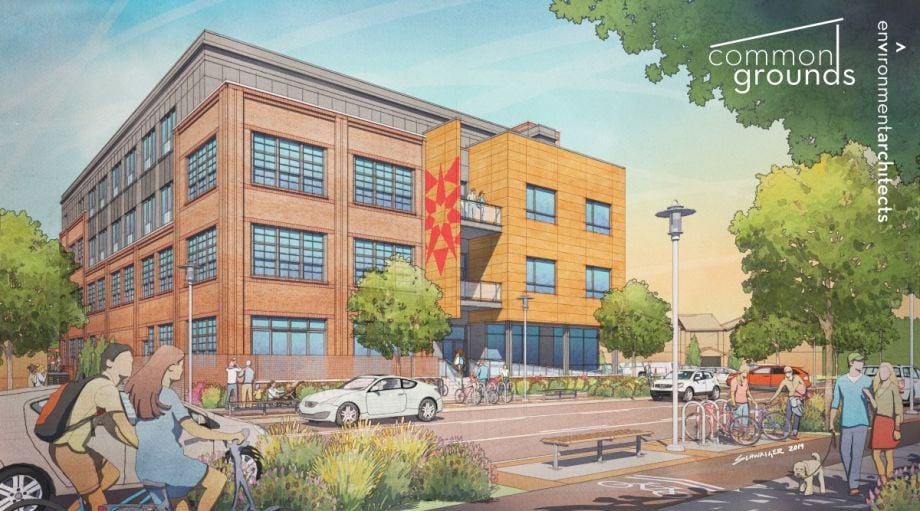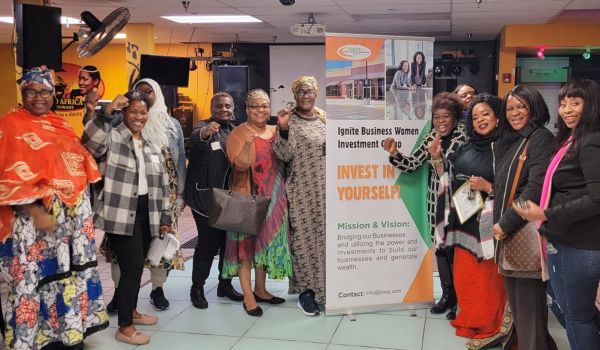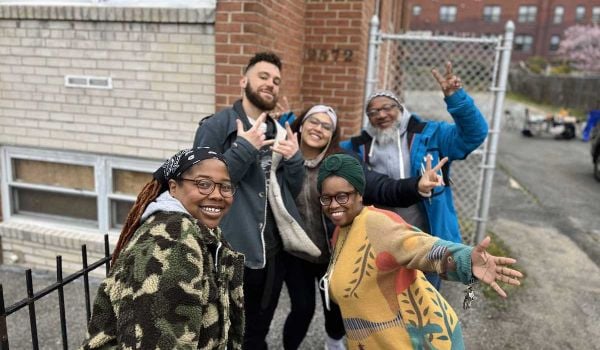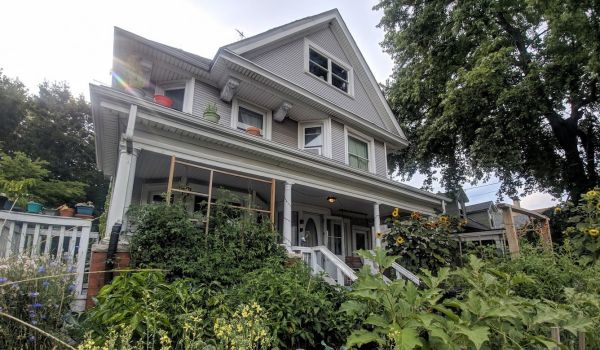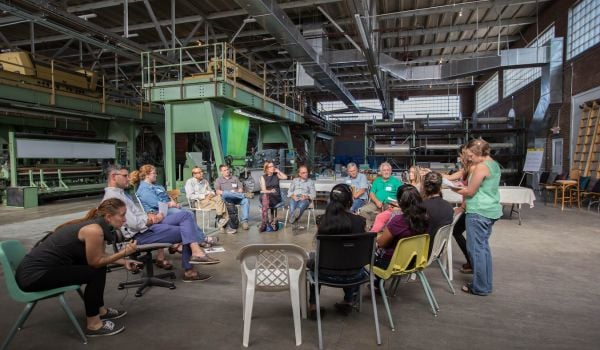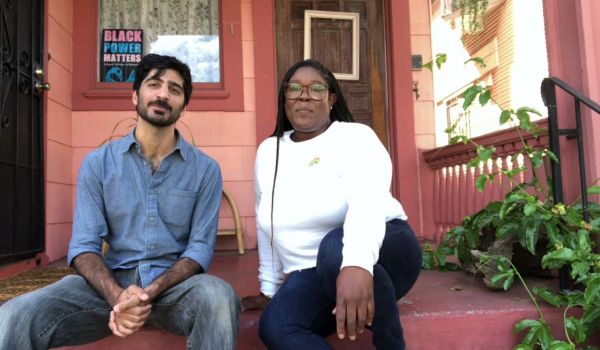It was a cold, windy, January evening on the banks of the Boardman River in Traverse City, Michigan. One by one, 10 people walked up and shoveled a bit of birdseed into a bucket, each representing a funding source for the future Commongrounds Cooperative. (The birdseed started as a pun on “early bird investors” and ended up leading to the ceremony being called a “groundbeaking.”) Though the ceremony was a spin on the typical groundbreaking ceremony, this was no typical commercial real estate project.
Slated to finish construction and open its doors in early 2022 (there’s even a live webcam feed of the construction site), Commongrounds Cooperative will have space for an independent coffee roaster, a local craft distillery, a food hall with a shared commercial kitchen for hourly rental, a childcare facility, a performing arts space and 24 apartments — 18 of them below-market rate, serving various income levels.
But what really makes Commongrounds Cooperative such an atypical project is who owns it and how it was financed. The co-op is owned by a combination of the commercial tenants that will occupy it once it opens and members of their community — their customers, employees and other supporters as well as the residents once they move in.
First up at the “groundbeaking” was Andrew Lutes, membership director of the co-op. His shovel-full of birdseed represented the 535 and counting community-owners (of which he is also one) who each paid $50 for an ownership share in the co-op. After the building opens, they’ll have the right to elect two representatives to the co-op’s board and other benefits that the board will figure out later.
Next was Bob Otwell, who represented a handful of Traverse City and surrounding-area residents who helped secure the land for the co-op. It’s located along Traverse City’s 8th Street corridor, which the city wants to revitalize with new businesses and housing, with a focus on bike and public transit. There’s a bus stop right in front of the building and another within a block. Otwell and a few other early supporters cobbled together $550,000 to help buy the property on behalf of the co-op, which will pay them back with a small bit of interest over the course of ten years.
Next was a shovel-full of birdseed from Jeffrey Hickman, from Coastal States Bank — the largest single source of funding for the project. Though the bank is based in Hilton Head, South Carolina, Hickman actually lives in Traverse City and he’s part of a team of six at the bank who provide federally-guaranteed small business loans all across the lower 48 states. Hickman arranged for his bank to extend the co-op an $8 million, 30-year mortgage — terms that Hickman says wouldn’t be possible without a loan guarantee from the U.S. Department of Agriculture.
The next shovelful came from Shauna Treter, her husband Chris and their daughter Pearl, representing the six commercial tenant-owners of the co-op. The Treters live about a mile down Eighth Street from the site, and Chris is the founder of Higher Grounds, an independent coffee roasting company that imports coffee mainly from farmer co-ops in more than a dozen countries. Altogether the six commercial tenant-owners have invested a total of $1.2 million in cash equity to the project so far, each one contributing an amount based on the square footage they’ll be occupying in the building after it opens. The commercial tenant-owners will have the right to elect a majority of the co-op’s board.
“The real estate development model that’s predominant in our country and around the world is extractive, especially in towns [like Traverse City] where tourism is the predominant industry,” Treter says. “There are developers out there who are great people and have great hearts, but it’s subjective to their whims and profitability which requires doing certain things putting profit before community. This model looks to resolve that.”
Next came Joey DiFranco, whose shovelful of birdseed represented the 132 community investors who came together in a regulation crowdfunding campaign last winter. The campaign raised $1.37 million in debt financing for the co-op, with a median investment of $2,000. These community investors will also be paid back at a low interest rate over the course of ten years after the building opens.
Next up was Marty Colburn, city manager for Traverse City, with a shovel-full of seed representing the city’s $210,000 brownfield remediation grant and $1.2 million in tax-increment financing to help pay for the construction of underground parking at the site. Valerie Handy, chair of the co-op’s board, added a shovel-full of seed for $1.8 million from the Michigan Economic Development Corporation, a state agency. Kate Redman, project director for Commongrounds, added seed representing a $1.5 million loan from IFF, a Chicago-based community development financial institution or CDFI serving the midwest region. Laurel Manke added a shovel-full for $1.8 million in property-assessed clean energy or PACE financing. Finally, the last shovel-full of seed came from Steve Mora, part of the construction team for the building.
“A big part of our mission is to help the community have a voice in real estate development,” Redman says. “We live in an area where there is a lot of growth and development but the community doesn’t feel it’s really by them or for them.”
Similar concerns have spurred the emergence of other community-owned or cooperatively-owned commercial real estate projects across the country over the past few years, including Oakland, Portland, New Orleans, Chicago, and Atlanta. While housing co-ops have been around for decades, real estate co-ops for businesses are rarer, and don’t have as many reliable funding sources as there are for those in housing.
In Michigan, the seed for what is now CommonGrounds Cooperative first found fertile soil in 2014. Looking to revamp what had been a mostly car-oriented corridor, the city shrunk Eighth Street from four lanes to three and added bike lanes. Some complained about added congestion. Chris Treter sided with those who valued safety and less noise pollution from slower drivers — some of his employees even collaborated with a local musician to write and record an original song about it. The bike side won out, and the city eventually decided to upgrade the bike lanes to a bike track.
Sensing an opportunity, Treter started looking for a location along Eighth Street to expand production for Higher Grounds, which had built a cult following across the Midwest since its founding in 2002. Inspired by his farmer co-op suppliers and the work they did in their communities beyond growing coffee, Treter wanted this second location to co-locate in a facility that met other needs in the community, from childcare to performance space to affordable housing and more. The property at 414/416 Eighth Street was the perfect location.
“In order to put all the things in there that the community needed, one company was not going to be able to do it,” Treter says. “If this was just a development one person was developing it wouldn’t have the impact it already has and will have with all the synergies once it’s up and running.”
Redman was one of Treter’s early calls. A Michigan native, she had moved to Traverse City to work for a public interest law firm known for fighting real estate cases against big corporations. In addition to her legal work, she founded CommonPlace, a co-working space currently located across the street from the CommonGrounds site. The co-op’s name actually comes from combining CommonPlace and Higher Grounds. The co-working space will move into the new building as a tenant-owner after completion.
“My law practice over time evolved to nonprofits and small businesses, including cooperatives,” Redman says.
Redman’s legal interests led her to the Sustainable Economies Law Center — part of the team behind the East Bay Permanent Real Estate Cooperative in Oakland. The law center runs a legal fellows program connecting and educating attorneys across the country who are interested in things like cooperatives and community land trusts. Through those conversations, Redman had seen how cooperatives like EBPREC or the NorthEast Investment Cooperative in Minneapolis had raised investment directly from their communities.
After signing on a few hundred community owners, who each paid $50 for an ownership share in the co-op, that was an easy network to turn back to and ask if anyone would be interested in loaning the co-op some of their retirement savings or other savings. There are currently more than 600 community owners, and Redman hopes to get to a thousand before the building opens early next year.
“A lot of people don’t invest at all, or if they do they invest in a mutual fund on Wall Street,” Redman says. “So we would say ‘why not invest in 8th Street, not Wall Street, and hopefully get that social return and some financial return.’”
132 community investors answered the call last winter, investing a total of $1.37 million. But that still wasn’t nearly enough.
Many cooperatives, especially new ones, face difficulty raising capital from traditional sources. Sometimes it’s because lenders aren’t familiar with the model.
“We first tried to work with local lenders,” Redman says. “Since it’s a community based project that seemed like it made sense, particularly for local credit unions, which are also cooperatives so we thought there might be alignment there.”
Some credit unions were familiar with the cooperative structure — all credit unions are co-ops, after all — but the amount of capital CommonGrounds still needed was more than any single local credit union could handle due to regulatory limits. Redman says one credit union tried its best to serve as a lead lender to bring other credit unions on board, but that arrangement fell through.
“All the co-op owners and community investors maybe made banks uneasy too because they’re used to having a couple of big investors and that can be a headache if investors have trouble making decisions,” Redman says. “But our experience so far has been quite the opposite, because people have a smaller amount of money invested, just enough to care and feel like they’re a part of it, but not so much they’re not barging into meetings expecting to make decisions.”
Redman says they also learned relatively early on that it was likely going to require a loan guarantee to complete the “capital stack” for the project.
“Anybody who wants to do real estate development that isn’t already a big real estate developer, you really need some kind of guarantee to get a lender to work with you,” Redman says.
But waiting in the wings was Jeffrey Hickman, the banker. He’d heard about the project and thought it was interesting that it had raised capital from the community. What he didn’t know yet was that it was a cooperative.
“The groundswell was fascinating,” Hickman says. “It wasn’t really til Kate [Redman] and I started to talk that I learned more of the details, the history of it.”
In the search for a traditional lender, Redman had heard that the USDA does guarantee loans to cooperatives — like the Cherryland Electric Cooperative, which provides electricity to the rural areas around Traverse City (though not inside the city itself). The vice chair of the CommonGrounds interim board actually works at Cherryland. So Redman reached out to the local USDA office about the project, and eventually word got around to Hickman.
“I’ve been doing USDA loans for the better part of 25 years,” Hickman says. “An average year I’ll do maybe 6-8 of these loans, average size maybe $3 million.”
Hickman specializes in what’s known as the USDA Business & Industry Loan Guarantee Program. Eligible lenders include federal- and state-chartered banks, credit unions, savings and loan associations, and farm credit institutions. Eligible borrowers include Indian tribes, public entities, individuals, and for-profit or nonprofit entities, including corporations and cooperatives. But there’s a catch — by law, the program is only currently available for areas with a population of up to 50,000. Luckily, Traverse City has a population of just under 16,000.
“There are situations when, geographically, the math says a project is not eligible but it’s a perfect candidate otherwise,” Hickman says. “But like anything, you just learn over time the rules are the rules and some fit and some don’t.”
Congress could change the population thresholds for USDA’s programs — they’re set in the Farm Bill, which comes up for reauthorization every five years, most recently in 2018. The idea is to ensure USDA’s programs focus on rural areas.
The Small Business Administration makes similar loan guarantees that don’t have any geographic restrictions. Hickman also works with those programs. But the SBA rules currently make it impossible for most cooperatives to access its programs (though there are some in Congress now pushing to change that).
Hickman says it was no problem for the USDA that CommonGrounds happened to be a cooperative, since the agency’s staff have so much experience dealing with co-ops. From his perspective it was a bonus that there was so much community-buy in, from what are now more than 635 co-op owners to 132 community investors. The bank actually needs to go through its approval process first and commit to making the loan before the USDA will consider guaranteeing it. Having the community investors as well as any other funding including from the public sector lined up first helps the numbers crunchers on all sides feel comfortable about making or guaranteeing the loan.
“It really struck me off the bat the number of people willing to back this financially for what was really just a dream at that point,” Hickman says.
This article is part of The Bottom Line, a series exploring scalable solutions for problems related to affordability, inclusive economic growth and access to capital. Click here to subscribe to our Bottom Line newsletter.

Oscar is Next City's senior economic justice correspondent. He previously served as Next City’s editor from 2018-2019, and was a Next City Equitable Cities Fellow from 2015-2016. Since 2011, Oscar has covered community development finance, community banking, impact investing, economic development, housing and more for media outlets such as Shelterforce, B Magazine, Impact Alpha and Fast Company.
Follow Oscar .(JavaScript must be enabled to view this email address)



